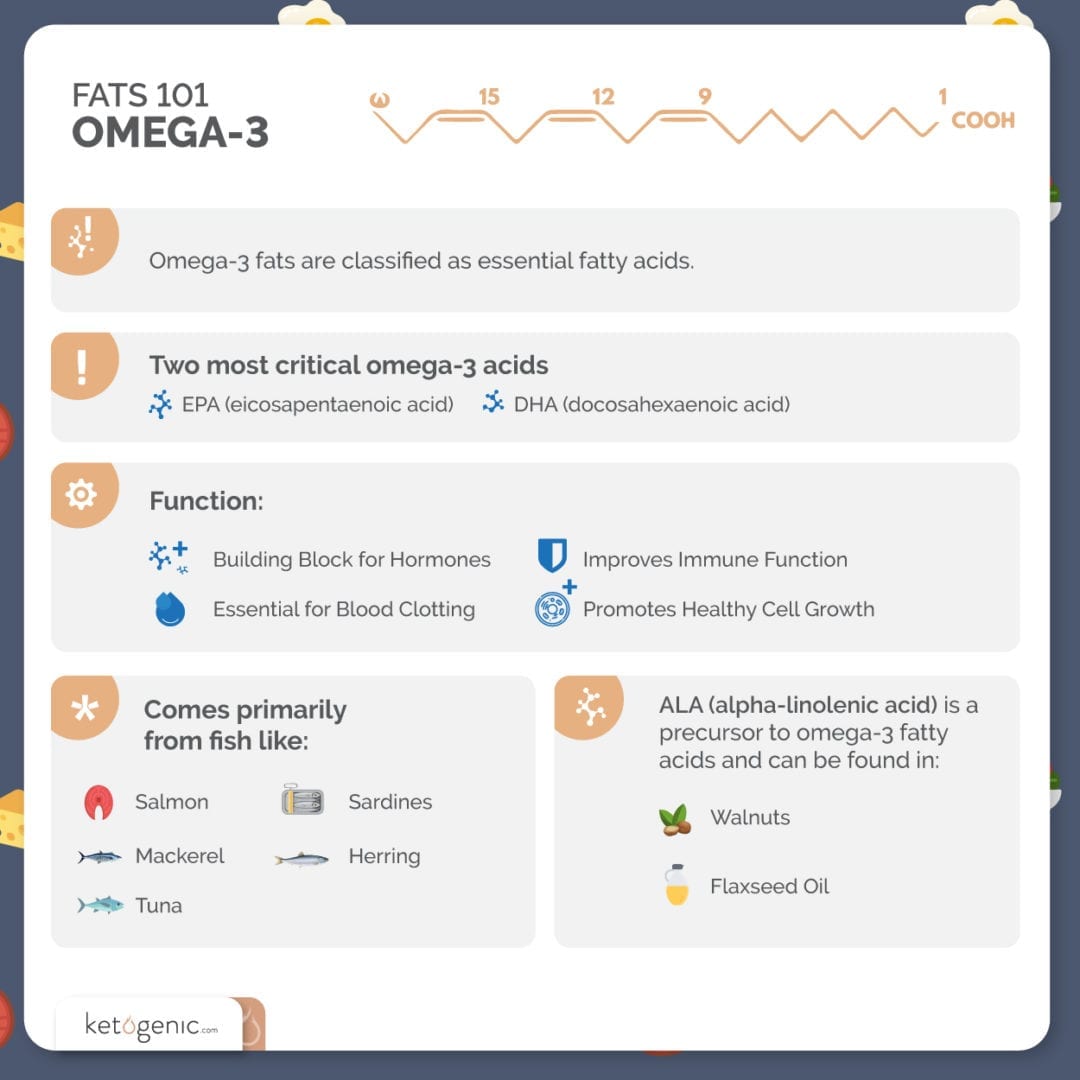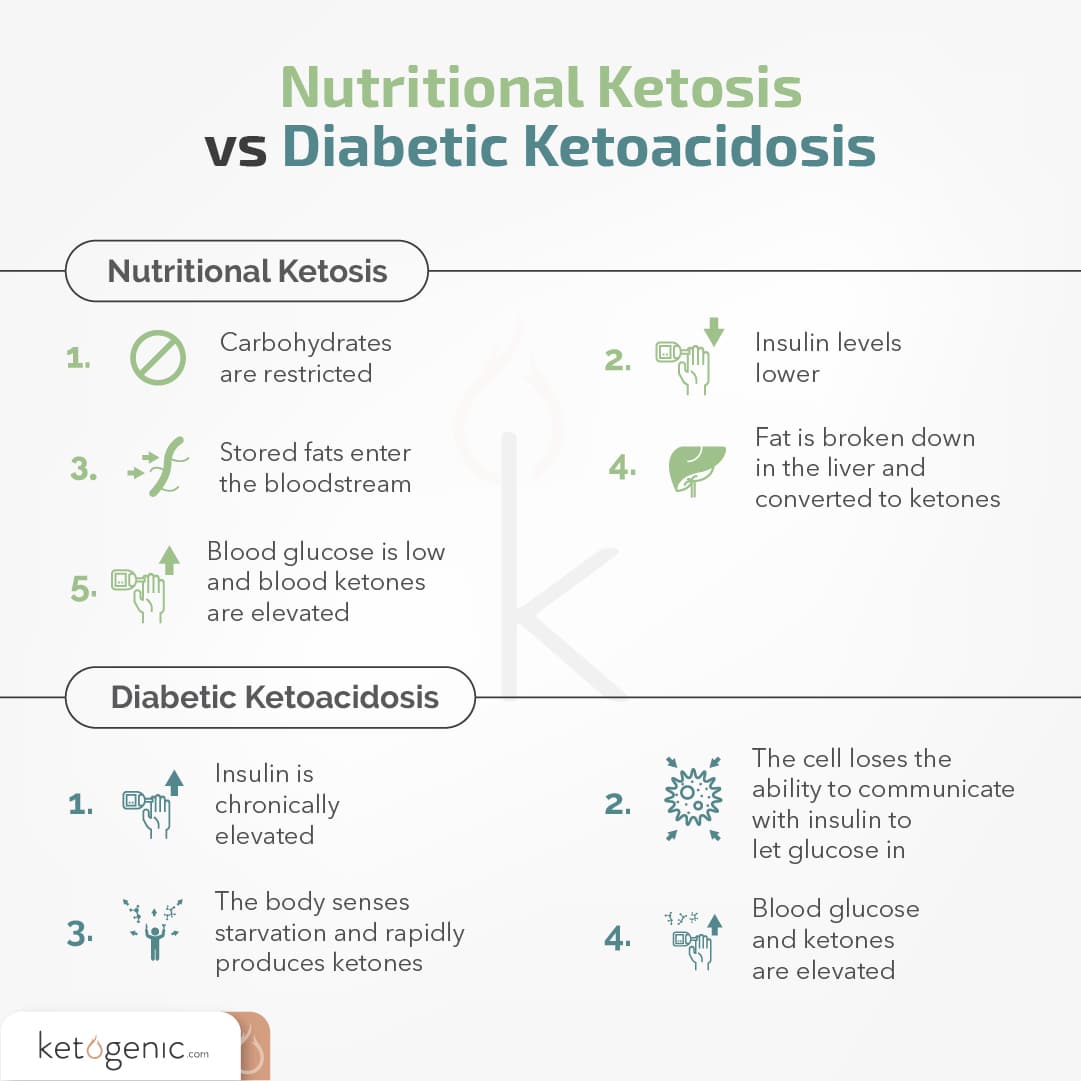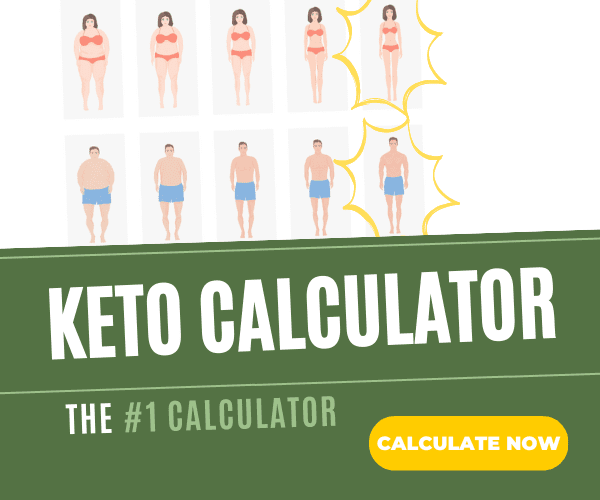Exactly What Is Fat and Why Do You Need It?

Fat is one of four macronutrients along with carbohydrates, protein, and alcohol. Fat is considered an essential macronutrient, which means that it is necessary for life similarly to essential amino acids (protein). Like the other macronutrients, there are many different types of fats and while some are important to our health, others are not required. But, what exactly is fat and why do you need it?
The function of fat includes the production of hormones, providing structural integrity for the cell, absorption of fat-soluble nutrients, the ability to be utilized or stored as energy, and aiding in the protection of vital organs [1]. In regards to the ketogenic diet, fat is responsible for making the ketone bodies that are produced in a ketogenic state and different types of fats such as medium-chain triglycerides can have advantages over other types of fat.
It should be understood that there is a distinction between dietary fat and stored body fat. While dietary fat can lead to stored fat when consumed in the presence of excess energy substrate, it should be noted that there is not a direct correlation between the two. For the sake of this article, we will primarily discuss dietary fat (or rather the fat you consume).

What is Fat?
Unlike carbohydrates and protein, which yield four calories per gram, fat yields nine calories per gram. Fats, like carbohydrates, are composed of carbon, oxygen, and hydrogen; however, fat contains these molecules in a much greater amount. For this reason, fats are more calorically dense than the other macronutrients. Additionally, a larger amount of energy is required to break fats down than that of carbohydrates and protein.
Fats can be divided into two distinct categories based on their biochemical structure; saturated and unsaturated. To be “saturated” means to contain high amounts of hydrogen, which means that for every carbon atom there are two hydrogen atoms. Coconut oil is an example of a fat-containing mostly saturated fat.
Unsaturated fats can be further divided into three separate categories, which include monounsaturated, polyunsaturated, and trans. Monounsaturated fats, unlike saturated fats, contain one double bond between two of the connecting carbon atoms. On the other hand, polyunsaturated fats contain two or more double bonds between the connecting carbon atoms, and the hydrogen atoms around the double bonds are on the same side of the double bond.
While most fat sources are comprised of multiple types of fatty acids, examples of monounsaturated and polyunsaturated fats are olive oil and fatty fish respectively.
Trans fats also contain double bonds, however, the hydrogen atoms are on the opposite sides of the double bonds. While trans fats can occur naturally, the bulk of the trans fats we consume can be found in processed foods such as vegetable oil. Trans fats can negatively impact your cardiovascular health and in particular your cholesterol levels.

Chain Length
Another difference between various fats is the chain length. Chain length is the number of carbon atoms that make up the chain of the molecule. Short-chain fatty acids are comprised of less than 6 carbon atoms, medium-chain fatty acids are comprised of 6-10 carbon atoms, and long-chain fatty acids are comprised of more than 10 carbons. This structural difference is important when we discuss the function and metabolism of fatty acids. Triglycerides, another term for fat, are comprised of three fatty acid chains and a glycerol carbon backbone. All dietary fats are made up of this basic structure.
Carbon chain length is one of determining factors behind the rate of fatty acid metabolism. Shorter chains are able to be metabolized quicker in comparison to longer chain fatty acids. This is due to the differences in the absorption processes of each fatty acid.Fats can also be classified as polyunsaturated omega-3, omega-6, and omega-9. This refers to the position of the double bond in unsaturated fats from the methyl (omega) end. In regards to these specific fats, omega-3 fatty acids contain a double bond between carbon three and carbon four, omega-6 between carbon six and seven, and omega-9 between carbons nine and ten. Within the omega-3, 6, and 9 fatty acids there are fats that are considered essential, which means that they cannot be synthesized by the body [2]. Omega-3 essential fatty acids include alpha-linolenic acid, an essential plant source, as well as eicosapentaenoic acid (EPA) and docosahexaenoic acid (DHA), which are animal sources [3].
ALA has potential ketogenic properties within itself due to the fact that it is the most beta-oxidized of the common long-chain fatty acids. Recent research has shown that consuming 2g of ALA daily in the form of flaxseed raised post-prandial ketone production by 26% in young adults [4].
Current recommendations for EPA and DHA are 500mg combined per day or four ounces of fatty fish two times per week for the healthy adult population. However, these requirements may increase or decrease depending on overall health, age, and pregnancy [5] [6]. EPA and DHA have been shown to have numerous health benefits in regards to cancer, cardiovascular, and metabolic diseases [3]. In fact, it was found that a ketogenic diet supplemented with omega 3 fatty acids decreased fasting and postprandial plasma triglyceride levels [7].
In regards to omega-6 fatty acids, linoleic acid is the primary essential fatty acid within this category [8]. Omega-6 fatty acids are primarily derived from plant sources and are abundant in the western diet. Current intake recommendations for omega-6 fatty acids are 17g per day for adult males and 12g per day for adult females.
Similar to omega-3 fatty acids, these recommendations change based on health status. Although needed in the diet, omega-6 fatty acids are consumed in excess in the western diet, thus causing an influx in the omega-3/omega-6 ratio. This ratio has been shown to have adverse health side-effects, which is the reason for the pro-inflammatory reputation of omega-6 fatty acids [10] [11].

Now that you have a better understanding of what fat is, we can discuss the various functions of fat.
What Is The Function of Dietary Fat?
1. Hormone Production
Fats are a major structural component of steroid hormones, specifical cholesterol. Cholesterol is considered a steroid hormone because it is converted to various hormones in the body including testosterone, aldosterone, progesterone, cortisol, estradiol as well as the derivatives of these hormones.
In regards to cholesterol and health, there are two primary forms of cholesterol that should be mentioned; very-low-density lipoprotein cholesterol (VLDL) and high-density lipoprotein cholesterol (HDL). VLDL contains the triglycerides synthesized in the liver from the fat in our diet. VLDL is then released into circulation for the delivery of triglycerides to storage sites. When VLDL has a triglyceride molecule removed from it, it becomes LDL.
LDL is referred to as “bad” cholesterol because it is correlated with an increased risk of cardiovascular disease [12]. However, looking at VLDL may be a better predictor of cardiovascular health. HDL cholesterol is referred to as “good” cholesterol because of its ability to transport cholesterol to the liver to be metabolized. HDL is correlated with a decreased risk of cardiovascular disease.
In a healthy human, cholesterol levels are regulated by HDL and LDL. Contrary to popular belief, in healthy individuals, dietary cholesterol (i.e., the cholesterol that you eat) has little effect on blood cholesterol due to regulatory processes of the body.

2. Cellular Makeup
Around cells, there is a layer called the cell membrane and this is comprised of fat. To be more specific, this layer is made of phospholipids, glycolipids, as well as previously mentioned cholesterol.
Phospholipids are a combination of a saturated fatty acid, unsaturated fatty acid, a glycerol group, and a phosphate group. Phospholipids comprise ~95% of the cell membrane [13]. A glycolipid is similar to a phospholipid in that they have a saturated fatty acid, unsaturated fatty acid, and a glycerol group. However, the main difference is that the phosphate group has been replaced with a sugar molecule.
Lastly, in small amounts within the cell membrane, cholesterol is found [14].
3. Nutrient Absorption
Fats are required for the absorption of a specific group of vitamins called fat-soluble vitamins. As the name indicates, these compounds can only be absorbed in the presence of fat and this includes vitamins A, D, E, and K [15].
The reason for this is fat-soluble vitamins have to be absorbed through the microvilli of the small intestine, which can only occur once they are dissolved in fat. These vitamins will be stored in the liver and adipose tissue, therefore if a balanced diet is consumed the need for supplemental fat-soluble vitamins may not be needed. With that being said, excess intake of fat-soluble vitamins may lead to adverse health effects [15].

4. Body fat vs. Dietary Fat
As mentioned earlier, it is important to note that dietary fat and body fat are very different and while dietary fat does not make you fat, excess fat consumption can lead to fat gain if not in proper caloric balance. Since the human body is efficient at storing fat and prefers to utilize carbohydrates, fat consumption in the presence of carbohydrates can also result in fat storage.Even the leanest individuals have large amounts of stored body fat. This is attributed to the need for a “back-up” source of energy in the absence of nutrients. Fat is stored as adipose tissue or what is thought of as “body fat” as well as visceral fat, which is the fat that surrounds and protects vital organs.
Not only that but the brain and liver are comprised primarily of fat, therefore this further reinforces the need for adequate fat intake since research demonstrates that a significantly low fat intake is associated with cognitive impairments [16].
5. Ketone Production
In regards to ketogenic dieting, fat has a crucial role in the production of ketone bodies: acetoacetate, beta-hydroxybutyrate, and acetone. These ketone bodies are formed through a process called ketogenesis in times of low carbohydrate availability when practicing a ketogenic diet, and sometimes in extreme cases such as diabetic ketoacidosis(DKA). DKA is a metabolic disorder in which cells cannot properly regulate glucose, therefore producing ketones at an uncontrollable rate. This phenomenon is what characterizes Type II Diabetics.
Fatty acids will travel to the liver where beta-oxidation occurs converting fatty acids to acetyl-CoA, acetoacetate, beta-hydroxybutyrate, or acetone. Acetoacetate and beta-hydroxybutyrate can be used by peripheral tissue to produce energy while acetone is normally exhaled or lost in the urine.
References
Seebohar, B. (2011). Nutrition periodization for athletes: Taking traditional sports nutrition to the next level. Bull Publishing Company.
Swanson, D., Block, R., & Mousa, S. A. (2012). Omega-3 fatty acids EPA and DHA: health benefits throughout life. Advances in Nutrition: An International Review Journal, 3(1), 1-7.
Kris-Etherton, P. M., Harris, W. S., Appel, L. J., & Nutrition Committee. (2002). Fish consumption, fish oil, omega-3 fatty acids, and cardiovascular disease. Circulation, 106(21), 2747-2757.
American Heart Association.(2016). Retrieved from heartcheckmark.org
Hennebelle, M., Courchesne-Loyer, A., St-Pierre, V., Vandenberghe, C., Castellano, C. A., Fortier, M., … & Cunnane, S. C. (2016). Preliminary evaluation of a differential effect of an α-linolenate-rich supplement on ketogenesis and plasma ω-3 fatty acids in young and older adults. Nutrition.
Vannice, G., and Rasmussen, H. (2014). Position of the Academy of Nutrition and Dietetics: Dietary Fatty Acids for Healthy Adults. J Acad Nutr Diet, 114:136-153. [online] Available at:
Volek, J. S., Gómez, A. L., & Kraemer, W. J. (2000). Fasting lipoprotein and postprandial triacylglycerol responses to a low-carbohydrate diet supplemented with n-3 fatty acids. Journal of the American College of Nutrition, 19(3), 383-391.
Linus Pauling Institute, Oregon State University. (2016). Essential Fatty Acids. Retrieved from http://lpi.oregonstate.edu/mic/other-nutrients/essential-fatty-acids#metabolism-bioavailability
Institute of Medicine. (2002). Dietary Reference Intakes for Energy, Carbohydrate, Fiber, Fat, Fatty Acids, Cholesterol, Protein, and Amino Acids. Washington, D. C.: National Academies Press
Simopoulos, A. P. (2002). The importance of the ratio of omega-6/omega-3 essential fatty acids. Biomedicine & pharmacotherapy, 56(8), 365-379.
Goodnight, S. H., Harris, W. S., Connor, W. E., & Illingworth, D. R. (1982). Polyunsaturated fatty acids, hyperlipidemia, and thrombosis. Arteriosclerosis, Thrombosis, and Vascular Biology, 2(2), 87-113.
Kanter, MM, Kris-Etherton, PM, Fernandez, ML, Vickers, KC, Katz, DL. Exploring the Factors That Affect Blood Cholesterol and Heart Disease Risk: Is Dietary Cholesterol as Bad for You as History Leads Us to Believe? Adv Nutr, (3): 711-717.
“Membrane Structure and Function.” University of Texas Medical Branch. Cell Biology Graduate Program. 23 September 2005.
Watson, H. (2015). Biological membranes. Essays In Biochemistry, 2015, 59 43-69; DOI: 10.1042/bse0590043
Bellows, L. and Moore, R. (2012). Fat-Soluble Vitamins: A, D, E, and K. Retrieved from http://extension.colostate.edu/topic-areas/nutrition-food-safety-health/fat-soluble-vitamins-a-d-e-and-k-9-315/
Kalmijn, S. V., Van Boxtel, M. P. J., Ocke, M., Verschuren, W. M. M., Kromhout, D., & Launer, L. J. (2004). Dietary intake of fatty acids and fish in relation to cognitive performance at middle age. Neurology, 62(2), 275-280.










